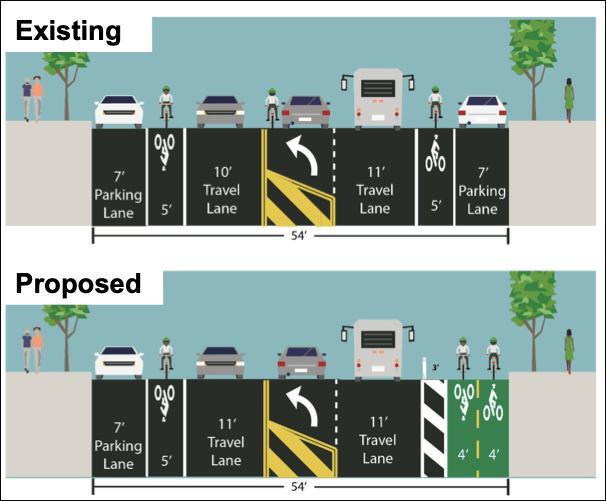DOT Will Pull the Trigger on Navy Street Protected Bike Lane

Set sail for a safer future.
The Department of Transportation quietly announced on Tuesday that it was moving ahead with a protected bike lane on Navy Street, filling in a missing link connecting the Brooklyn waterfront to DUMBO and the Manhattan and Brooklyn Bridges.
According to a tweet by the agency, workers will begin to install a two-way protected bike lane between Sands Street and Flushing Avenue on the east side of Navy Street this month, a project that will upgrade the current one-way unprotected bike lane into a plastic bollard-protected link to the new protected bike path on Flushing Avenue.

This small improvement would normally not even make the pages of Streetsblog, but street safety supporters were left to wonder about the fate of the project after Brooklyn Community Board 2’s executive committee voted against the project to preserve 14 parking spaces on the single block where the bike lane would go. In the wake of that vote, the DOT went silent and did not answer questions about the fate of its own project, but Tuesday’s announcement was celebrated as the right decision.
“We salute Commissioner Gutman and his team for doing the right thing and moving ahead with the critical Navy Street connection between the Sands and Flushing Avenue bike paths,” said Bike New York Director of Communications Jon Orcutt.
As advocates waited for the decision from the DOT, Bike New York pointed out that in 2019, Borough President (and future Mayor) Eric Adams told DOT that “the current conventional bike lane on Navy Street does not provide adequate protection from vehicles traveling at high speeds in both directions and making right turns onto Tillary Street.” The Beep’s letter specifically requested a protected bike lane that extended all the way to Myrtle Avenue, something that the de Blasio administration said was going to be installed in 2020 as part of a protected lane from Ashland Place to Sands Street, but has since appeared let fall by the wayside. (It is not on the agency’s current project page, the Bible of street safety watchers.
Brian Howald, a street safety activist and CB2 member, tweeted his support of the project that he said would help 4,000 daily cyclists, but pointed out that much work remains to create a unified network of protected bike lanes — one that would link the new paths to and from the Manhattan Bridge to the new PBL on Fourth Avenue or to Prospect Park.
There is, in fact, no bike lane network if there are gaps in it.
4,000+ people who ride this block every day (technically, just 18 hrs.) will have safer rides to and from the Manhattan + Brooklyn Bridges.
The next steps are:
– protected access to 4th Ave. PBLs via Navy St. + Ashland Pl.
– protected access to Prospect Park W. https://t.co/bdjA66PafR— Brian Howald (@bdhowald) September 7, 2021


